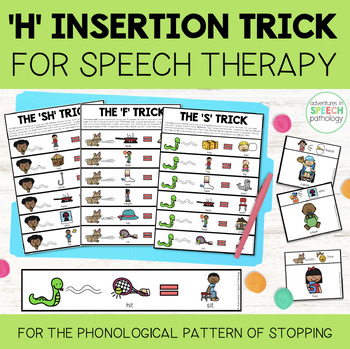The H Insertion Trick for Speech Therapy
- PDF
What educators are saying
Description
Are you targeting stopping, but your child continues to insert a plosive between the target fricative sound and the rest of the word?
e.g., they say “fbeet” for feet
“shtip” for ship
“chtair” for chair
The ‘h’ insertion trick (also described as the aspiration trick by Dr. Caroline Bowen) essentially tricks students into saying words starting with voiceless fricatives, affricates and plosives accurately. By using visuals and blending the initial target sound with a word starting with /h/, children might be able to say their target words clearly.
DOWNLOAD THIS RESOURCE IF YOU WANT:
➊--Cues to help students say words starting with voiceless fricatives when they insert a plosive after the initial sound
❷--To try different types of cues, and nothing has helped “click”
❸--To move forwards in therapy and you're unable to do minimal pairs
❹--A trick to help students say voiceless sounds correctly
Who can you use this for?
1. STOPPING: It can be helpful for those students who can say their target sound in isolation but continue to ‘stop’ the airflow so that “fan” is produced as “fban” and “soup” is said as “stoup” or “sdoup”.
2. VOICING: You might also find that this trick works well for students who are voicing a voiceless plosive at the start of their words.
3. OTHER IDEAS: I haven't personally used this for fronting or backing, but I have received feedback from SLPs who state that this trick has been useful for them to elicit the /k/ and /t/ sounds before proceeding to contrast therapy.
⭐ Learn more about this trick! Watch on YouTube or read more on our blog.
============================================================
CONTENTS:
✅ -- Total of seven sounds included: /tʃ, f, k, p, s, ʃ/ and /t/.
✅ -- 78 flashcards featuring the target sound with cues above
✅ -- 7 initial sound cue flashcards
✅ -- 12 target words per sound (except /tʃ/)
✅ -- Includes EBP pages, how to use the trick and and YouTube clip
✅ -- The resource comes in color and black & white
============================================================
What SLPs like you are saying:
❝ Super helpful and comprehensive! Thank you! This has helped so many of my students 'get it'.❞
❝ This is the best resource for kids who have sound additions! I've used this with multiple kids and it almost immediately does the trick with reducing sound additions/substitutions. ❞
❝ This has been a life changer! It has helped so many of my clients who get stuck using those tricky long sounds. A must have for any SLP working on speech!❞
⭐ Are you looking for similar visuals to help you with /s/, /ɹ/, and /l/ clusters?⭐
IMPORTANT INFORMATION: This is a digital file and is licensed for one person to use. Printing and assembly of the product may be required. For more information about single-person use, please refer to our Terms of Use.
Do you need FREE 100 Trials for Speech no-prep worksheets? Sign up for my newsletter to get access to my Freebie Library of goodies that are aimed at your speech sound caseload.
ABOUT THE AUTHOR: Rebecca Reinking is an SLP who works privately with children who have speech sound disorders. She has a particular interest in phonological interventions and strives to connect and collaborate with speech scientists to bridge the gap between research and clinical practice.
- Follow our 100,000-strong Instagram account: @adventuresinspeechpathology
- Learn more about treating speech sound disorders and join our email list
- Contact our support team: support@adventuresinspeechpathology.com
- Watch therapy clips on YouTube: youtube.com/c/AdventuresinSpeechPathology





